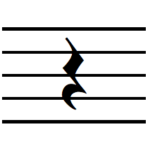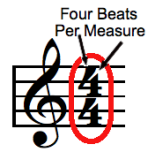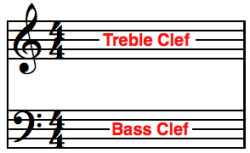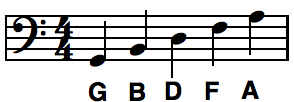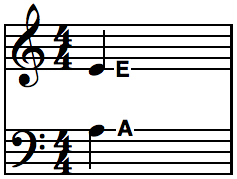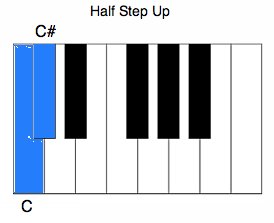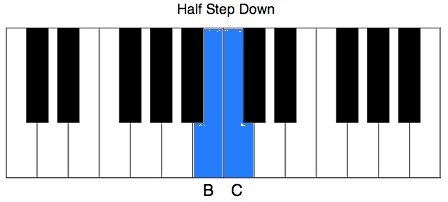The Cm Chord is a minor chord that derivatives from a C Major Chord.
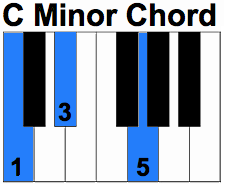
The notes in this chord are C, Eb and G.
This can easily be compared to the C Major Chord in that the notes in a C Major Chord are C, E, and G while the notes in the C Minor Chord are C, Eb, and G.
Notice the difference between the C Minor Chord and C Major Chord is there is an Eb instead of an E.
The three notes in this can be found by using two different approaches. The interval approach and the number approach.
Each of these approaches are useful in finding chords. If you can memorize each approach for a certain chord, you can then apply it to any of the 12 keys. This is helpful when transposing to alternate keys.
Quick Tip!
The notes in the Cm Chord are C, Eb, G
Building a Cm Chord
Number Approach
Using the number approach to find the C Minor Chord is a very simple method. The formula for this chord is using the 1, Flat 3rd and 5.
To locate the notes you will start with the root note of C which is the 1.
Next find the third note in the scale and make it a flat. This is where the Eb note comes from. This is what’s called using a Flat 3rd.
To find the last note in the chord, count up the C Major Scale to the Fifth note and this will be the top note in the chord.
Quick Tip!
The number formula for the Cm Chord is 1-b3-5
Interval Approach
Using the intervallic approach uses intervals identify the notes in the chord.
To find the notes in the Cm Chord using this approach start with the root note of C. Then add the minor third on top of that which will is Eb. To find the top and final note add the perfect fifth or the G on top.
The formula would then be:
Root – Minor Third – Perfect Fifth
Take a look at the image below and you will see how each interval stacks on top of the other forming the chord.
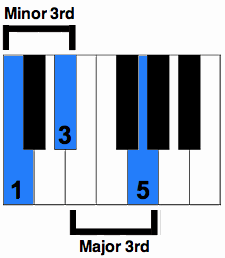
This chord is almost identical to C Major Chord with only one small difference. Rather than playing an E natural like in the C major chord you are going to play an Eb giving you C, Eb and G.
Inversions
Like all chords, the C minor chord has three notes, making it a triad. Because there are three notes in this chord there will be three different ways that we can play it.
Inversions are simply adjusting the order of the notes creating a different sound for the chord. For example: rather then starting the chord on C you would start it on either the Eb or G.
The first inversion is going to be the root inversion which we have talked abut throughout this page. Starting on the C and playing the rest of the notes in the chord; Eb and G. This is the standard inversion and starts on the root note of the scale.
The first inversion is going to be taking the lowest note, the C, and moving it to the top of the chord. This chord will start on Eb and add the G and C on top.
The second inversion of the Cm chord is going to start with the G as the lowest note. Then add C and end with Eb on top.
Use the image below to see how each note is moved from the bottom of the chord to the top of the next inversion.
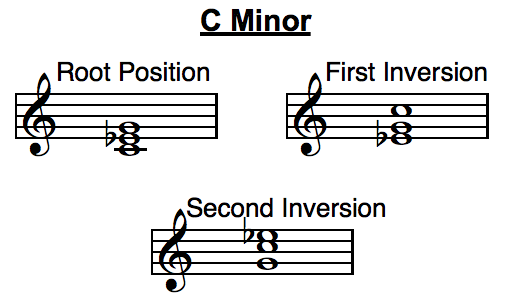
Fingering
Right Hand Fingering
The fingering for the Cm chord is similar to that of a major chord. The right hand fingering for the root inversion is going to start with the first finger or the thumb, on the C, the third finger on E flat and the fifth finger on G.
The first inversion is going to have the first finger on the E flat, the second finger on G and the fifth finger on the top of the chord on the C.
The second inversion is going to start with the first finger on G, the second finger on C and the fifth finger on E flat.
Use the image below as a guide for proper fingering for the Cm Chord.
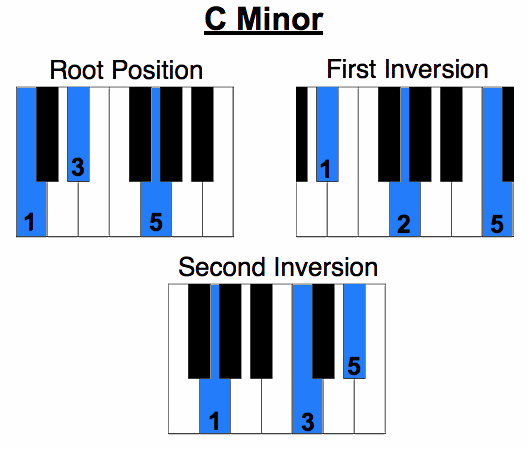
Left Hand Fingering
Fingering for the left hand for the root inversion starts with the fifth finger on C, third finger on Eb, and the fifth finger on G.
The fingering for the first inversion of the Cm chord is going to start with the fifth finger on Eb, the third finger on G, and the first finger on C.
The second inversion for the C minor chord is going to start with the small finger or the fifth finger on G, the second finger on C, and the fifth finger on Eb.
Uses of the C Minor Chord
The Cm chord is commonly used in the key of Eb, and is also commonly used in the key of Bb.
In the key of Eb, this chord is commonly used as the minor six chord of the key. You can also start a song with the C minor chord. Generally this chord follows after a Ab Major Chord or a Bb Major Chord.
In the key of Bb, the C minor chord can be used as the minor second chord which can commonly be used in a bridge of a song. It can also be followed by an F Major Chord.
This chord is very easy to learn because it is a derivative of C major chord. The C major chord is generally the first chord that a beginner piano player learns.
In order to play this chord easily is to start by playing a C major chord, and then adjust the chord by moving the third note of E to Eb.
If you need more help learning chords The Piano Chord Encyclopedia is a great resource. It includes Fingering, Inversions, and Music Notation for over 645 different chords. Check it out Here.
Go From Cm Chord Back to Piano Chords
Back to Home Page










